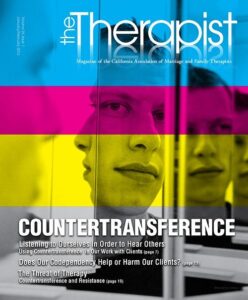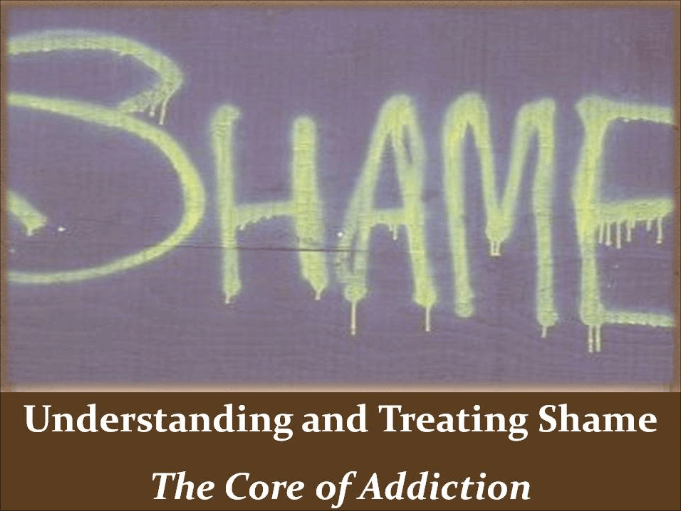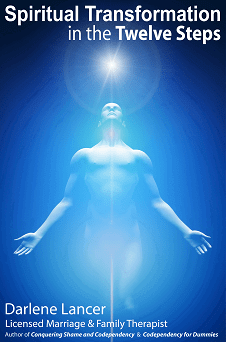Does Our Codependency Help or Harm Our Clients?
 A bit of codependency probably is a prerequisite to becoming a therapist, and perhaps essential to being a good one. Who else would take such pleasure in focusing on helping others – often at the expense of their own needs. Whether our codependency helps or harms the therapy turns on self-awareness. My article for codependency professionals in CAMFT’s The Therapist discusses how countertransference and codependency affect treatment.
A bit of codependency probably is a prerequisite to becoming a therapist, and perhaps essential to being a good one. Who else would take such pleasure in focusing on helping others – often at the expense of their own needs. Whether our codependency helps or harms the therapy turns on self-awareness. My article for codependency professionals in CAMFT’s The Therapist discusses how countertransference and codependency affect treatment.
Get the new webinar course on Countertransference in Treating Shame and Codependency.
Shame impacts our countertransference. Watch part of my talk at Cedars-Sinai Hospital in Los Angeles at “Perspectives on Addiction.”
For CEU’s, at www.GoodTherapy.org listen to my 9-20-2013 seminar Codependency and Countertransference.
Listen to this presentation to counselors at Southern California Counseling Center. Part I discusses the symptoms and causes of codependency: Click: SCCC I.
Understanding and Treating Shame
 Shame has many faces, among them, self-hatred, contempt, envy, anxiety, loneliness, aggression, perfectionism, depression and emptiness. It fuels arrogance equally with pride’s opposite, self-doubt and insecurity. It’s the elephant in the room that underlies most clients’ complaints.
Shame has many faces, among them, self-hatred, contempt, envy, anxiety, loneliness, aggression, perfectionism, depression and emptiness. It fuels arrogance equally with pride’s opposite, self-doubt and insecurity. It’s the elephant in the room that underlies most clients’ complaints.
As clinicians, by understanding our reactions and countertransference, we can help build clients’ self-awareness, challenge their beliefs, and intervene to treat shame’s childhood roots in underlying traumatic events.
Get the full webinar, Understanding and Treating Shame.
Read “Shame – the Elephant in the Room” published in Social Work Today.
WCSAD Conference: Listen to an excerpt of Understanding and Treating Shame:
Learn more. Download the full webinar, Understanding and Treating Shame.
Genesis Programs: Excerpt from Seminar on Codependency, Shame, and Countertransference:
Get the one-hour webinar Codependency, Shame, and Countertransference.
Sierra-Tucson Seminar: Shame and Codependency. Watch an excerpt on YouTube.
Learn more. Download the full webinar Understanding and Treating Shame.
How to Build Self-Esteem
 Sovereign Health Seminar: How to Build Client’s Self-Esteem. Watch an excerpt on Youtube.
Sovereign Health Seminar: How to Build Client’s Self-Esteem. Watch an excerpt on Youtube.
Buy the webinar How Raise Your Self-Esteem, and request the Powerpoint tailored for professionals for an additional $19.95.
Peer-Reviewed Articles for Codependency Professionals
“Sibling Abuse: The Hidden Epidemic”

Sibling abuse is the most common, but least reported abuse in the family. Prevalence is higher than spousal or child abuse combined, and can have consequences in adulthood similar to parent-child abuse. Sibling maltreatment affects up to 80 percent of youth. It’s been called the “forgotten abuse.”
Parents typically overlook it thinking it’s sibling rivalry, compounding victims’ trauma. Ask clients about sibling abuse.
Read the full article on sibling abuse published in The Therapist.
“Perspectives on Emptiness”

Emptiness can describe different states depending on our perspective―whether spiritual, philosophical, or psychological, ranging from joyful realization of the ultimate reality to meaninglessness and alienation.
When facing despair, patients often experience psychological emptiness, which is correlated with depression and rooted in shame that originates in childhood. It can lead to addictive behavior and codependency, “a disease of a lost self.” Drawing on philosophers, psychoanalytic theorists, and clinicians, this article explores states of emptiness and ways to approach it individually and clinically.
Read the full article published in Psychology and Behavioral Science International Journal.
“Can a Narcissist Love?”

Narcissists claim to love their children, parents, and partners, but do they? Anyone who’s loved a narcissist wonders, because they can offer warm companionship followed by demeaning behavior.
Narcissists don’t see themselves or others clearly. They overestimate their emotional empathy and experience other people as extensions of themselves. Plus, the defenses they use to regulate their emotions and self-esteem distort their perceptions and interactions with people. They self-promote and withdraw to control closeness and vulnerability, project onto others negative aspects of themselves, and use denial, entitlement, and narcissistic abuse to ward off shame.
Read the full article as published in The Therapist.
“The Problem of Narcissists”

The gods sentenced Narcissus to a life without human love. In love with his own reflection, he died hungering for its response. It’s a misconception that narcissists love themselves. Their self-flattery and arrogance cover up the self-loathing they don’t admit–usually even to themselves. Instead, it’s projected outwards with disdain and criticism of others. They’re afraid to look at themselves, because of shame. Actually, they don’t have much of a Self at all. Emotionally, they’re dead and hunger to be filled and validated by others. Sadly, they’re unable to appreciate the love they do get and alienate those who give it.
Read the full article about the diagnosis, cause, manifestation in relationships, and treatment for narcissism and NPD or as published in The Therapist.
“Recovery in the Twelve Steps”

Carl Jung believed that unity and wholeness of the personality, which generates a sense of acceptance and detachment, occurs when both the conscious and unconscious demands are taken into account — when not the ego, but the Self, is at the center of consciousness. He felt his life was “a story of the self-realization of the unconscious,” and rediscovered, as suggested by the Twelve Steps, that God was “a guiding principle of unity.”
Jung corresponded with Bill Wilson, a founder of Alcoholics Anonymous and an author of the Steps. They lead to surrender of the ego as envisioned by Jung. Often therapists don’t understand that the Steps are far more than a prescription for sobriety, but are psycho-spiritual guidelines for nothing less than a total personality transformation. This article discusses how each of the Steps works to accomplish this feat and is applicable for both codependency professionals and clients.
Read the full on “Spiritual Transformation in the Twelve Steps” as published in The Therapist.
“Helping Clients in Narcissistic and Abusive Relationships”
 This is a 2-hour continuing education webinar for mental health and codependency professionals based on the book, Dating, Loving, and Leaving a Narcissist: Essential Tools for Improving or Leaving Narcissistic and Abusive Relationships. The seminar provides a roadmap to help clients in relationships with narcissists and is applicable to any abusive relationship, such as with substance abusers, or other personality-disordered individuals. I describe how to support and provide psychoeducation to clients to effectively confront psychological abuse and thereby build their self-esteem and become more satisfied with the relationship and/or prepare to leave the relationship.
This is a 2-hour continuing education webinar for mental health and codependency professionals based on the book, Dating, Loving, and Leaving a Narcissist: Essential Tools for Improving or Leaving Narcissistic and Abusive Relationships. The seminar provides a roadmap to help clients in relationships with narcissists and is applicable to any abusive relationship, such as with substance abusers, or other personality-disordered individuals. I describe how to support and provide psychoeducation to clients to effectively confront psychological abuse and thereby build their self-esteem and become more satisfied with the relationship and/or prepare to leave the relationship.
I discuss the diagnosis, types, and deep motivations of different narcissists and their partners to identify the underlying psychological processes that drive the behavior of narcissists and their loved ones. I explain narcissistic defenses and the variety and subtle forms of narcissistic abuse. Although abuse must be confronted, the usual methods are rarely successful and may dangerously escalate abuse. I review the do’s and don’ts of confrontation as well as strategies and action steps that victims address abuse and get their needs met. By understanding the partners’ motives and intrapsychic and interpersonal relationship dynamics, clinicians can help clients regain their power in these relationships. The seminar will:
- Identify diagnostic criteria for narcissistic personality disorder and four types of narcissistic individuals.
- Recognize narcissistic defenses and forms of narcissistic abuse.
- Describe mindset, motives, and psychodynamic features that drive narcissistic behavior.
- Explain the common role of shame and the psychological challenges for narcissists and their partners in intimate relationships.
- Describe the steps necessary to empower clients in abusive relationships.
Get the 90 min audio seminar. Watch on Goodtherapy.org for CE credits.
